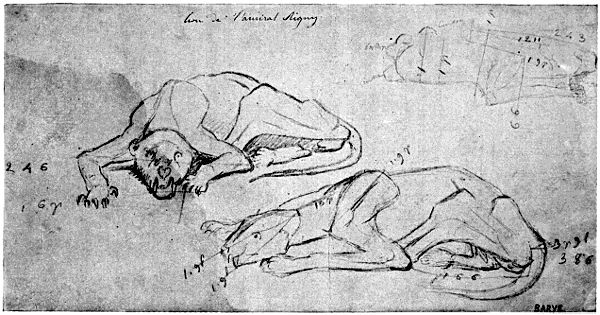Please see Transcriber's Notes at the end of this document.
THE
ARTISTIC ANATOMY OF ANIMALS

PREFACE
A few lines will suffice to explain why we have compiledthe present volume, to what wants it responds, and whatits sphere of usefulness may possibly embrace.
In our teaching of plastic anatomy, especially at the Écoledes Beaux-Arts—where, for the past nine years, we havehad the very great honour of supplementing the teachingof our distinguished master, Mathias Duval, after havingbeen prosector for his course of lectures since 1881—it isour practice to give, as a complement to the study of humananatomy, a certain number of lessons on the anatomy ofthose animals which artists might be called on to represent.
Now, we were given to understand that the subjecttreated in our lectures interested our hearers, so much sothat we were not surprised to learn that a certain numberrepeatedly expressed a desire to see these lectures unitedin book form.
To us this idea was not new; for many years the work inquestion had been in course of preparation, and we hadcollected materials for it, with the object of filling up avoid of which the existence was to be regretted. But ourmany engagements prevented us from executing our projectas early as we would have wished. It is this workwhich we publish to-day.

Fig. I.—Reproduction of a Sketch by Barye (Collections of the Anatomical Museum of the École desBeaux-Arts—Huguier Museum).
Putting aside for a moment the wish expressed by ourhearers, we feel ourselves in duty bound to inquire whetherthe utility of this publication is self-evident. Let it beclearly understood that we wish to express here our opinion[vii]on this subject, while putting aside every personal sentimentof an author.
No one now disputes the value of anatomical studiesmade in view of carrying out the artistic representation ofman. Nevertheless—for we must provide against all contingencies—theconviction on this subject may be more orless absolute; and yet it must possess this character in anintense degree in order that these studies may be profitable,and permit the attainment of the goal which isproposed in undertaking them. It is in this way that weever strive to train the students whose studies we direct;not only to admit the value of these studies, but to bematerially and deeply convinced of the fact without anyrestriction. Such is the sentiment which we endeavour tocreate and vigorously encourage. And we may be permittedto add that we have often been successful in thisdirection.
Therefore it is that, at the beginning of our lectures, andin anticipation of possible objections, we are accustomedto ta